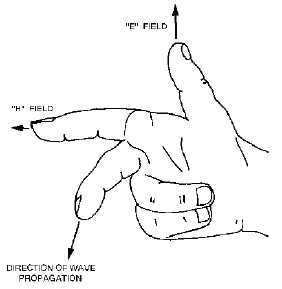2-11
If you know the directions of the E and H components, you can use the "right-hand rule" (see figure
2-6) to determine the direction of wave propagation. This rule states that if the thumb, forefinger, and
middle finger of the right hand are extended so they are mutually perpendicular, the middle finger will
point in the direction of wave propagation if the thumb points in the direction of the E field and the
forefinger points in the direction of the H field. Since both the E and H fields reverse directions
simultaneously, propagation of a particular wavefront is always in the same direction (away from the
antenna).
Figure 2-6.—Right-hand rule for propagation.
Q8. If a transmitting antenna is placed close to the ground, how should the antenna be polarized to
give the greatest signal strength?
Q9. In the right-hand rule for propagation, the thumb points in the direction of the E field and the
forefinger points in the direction of the H field. In what direction does the middle finger point?
ATMOSPHERIC PROPAGATION
Within the atmosphere, radio waves can be reflected, refracted, and diffracted like light and heat
waves.
Reflection
Radio waves may be reflected from various substances or objects they meet during travel between
the transmitting and receiving sites. The amount of reflection depends on the reflecting material. Smooth
metal surfaces of good electrical conductivity are efficient reflectors of radio waves. The surface of the
Earth itself is a fairly good reflector. The radio wave is not reflected from a single point on the reflector
but rather from an area on its surface. The size of the area required for reflection to take place depends on
the wavelength of the radio wave and the angle at which the wave strikes the reflecting substance.
When radio waves are reflected from flat surfaces, a phase shift in the alternations of the wave
occurs. Figure 2-7 shows two radio waves being reflected from the Earth's surface. Notice that the
positive and negative alternations of radio waves (A) and (B) are in phase with each other in their paths
toward the Earth's surface. After reflection takes place, however, the waves are approximately 180
degrees out of phase from their initial relationship. The amount of phase shift that occurs is not constant.

